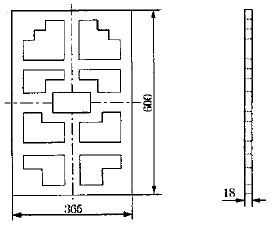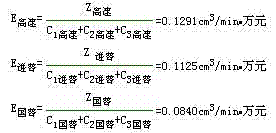1. Calculation of processing efficiency
According to the traditional cutting theory, the cutting efficiency ZW (cm3/min) can be calculated by the following formula:
ZW=v·f·ap (1)
Where v---cutting speed; f---feeding amount; ap---cutting depth
According to analysis and research, we believe that equation (1) is not suitable for the calculation of high-speed milling efficiency. There are two main reasons:
1) The spindle speed of high-speed milling machine is quite high (such as HSM-700 high-speed milling machine with a maximum speed of 42000r/min, and the machining plane speed is also 35000r/min, above). This high speed makes the tool not every turn. Cutting metal
2) In the actual machining, the set speed and feed rate are only the maximum speed and the maximum feed. The actual tool speed and feed time are changing (the self-test function of the HSM-700 machine can display the whole cutting process). The change in the process), the actual speed and feed rate during the cutting process always quickly reach a higher value from a lower value and quickly drop to a lower value, so repeated changes, this is an objective reflection of the milling process, and not The speed and feed rate can be kept constant during the turning process.
Therefore, we propose to use the metal removal amount Z (cm3/min) per unit time to represent the processing efficiency, ie
 (2)
(2)
W---Total metal removal during cutting (cm3)
t---cutting time (<0,)
Equation (2) is more in line with the actual situation of high-speed milling. It is easy to calculate the high-speed milling efficiency by using equation (2), and it is also convenient to compare the machining efficiency of different milling machines.
For example, the parts shown in Figure 1 were originally machined on a common milling machine. In order to shorten the production cycle, some parts are now processed by high-speed milling machines. In this way, the processing efficiency of the two processing equipment can be compared by machining the part. High-speed milling and general milling can meet the requirements due to the low surface quality requirements of the part. In fact, the surface roughness of parts machined by high-speed milling is one to two grades lower than that of ordinary milling.

Figure 1 Parts schematic
The processing efficiency is expressed by the metal removal amount Z=W/t (cm3/min) per unit time. During the test, several time periods during the milling process were taken, the machining time was recorded, and the volume difference before and after the machining of the parts was measured at each time period, and the Z value was calculated by the formula (2). The average value of Z is calculated by multiple measurements, which can be regarded as a more accurate Z value. For the high-speed milling process of the part shown in Figure 1, the Z value calculated by equation (2)

According to the traditional cutting theory, it is calculated according to formula (1).

Comparing the Z speed and the ZW, it is clear that the ZW differs greatly from the actual high speed milling efficiency of the part.
2. Comparison of processing efficiency of different milling machines
In addition to the HSM-700 high-speed milling machine, the milling machine currently used in a research institute also has a domestic vertical milling machine and an imported milling center. The domestic milling machine is the XK5040-1 vertical lifting table milling machine (hereinafter referred to as domestic ordinary milling machine) produced by Beijing No. 1 Machine Tool Plant purchased in the early 1990s. It is mainly used for rough machining of parts and a small amount of cast iron and steel. The processing of the parts; the imported milling center is the American-made VF-0 HAAS milling center (hereinafter referred to as the imported ordinary milling machine), which can be used for roughing and finishing.
For the parts shown in Figure 1, the cutting efficiency of machining on a domestic milling machine is

The cutting efficiency of machining on imported ordinary milling machines is

Compare Z high speed with Z Guopu and Z Jinpu respectively.

It can be seen from the above calculation and comparison that the metal removal rate of the part processed on the high-speed milling machine is quite high, and the advantage is more obvious than that of the domestic ordinary milling machine (according to the operator's reflection, even the high-speed milling machine has higher processing efficiency than the domestic ordinary Milling machines are more than 10 times faster). Of course, the processing efficiency of different milling machines is different for parts with different materials, different shapes and different processing requirements. For large parts with large processing areas or parts with particularly complex shapes, high-speed milling machines have a more significant processing efficiency advantage. The efficiency advantages of high-speed milling machines are mainly reflected in the high tool speed n and the high feed rate Vf. In actual machining, the feed rate Vf tends to have a greater influence on the machining efficiency.
3. Comparison of processing efficiency considering cost factors
The comparison of processing efficiency must have certain constraints. The relationship between processing efficiency and production cost should be considered in combination with the actual situation of the enterprise. The processing efficiency Z obtained by the equation (2) is divided by the processing cost C to represent the processing efficiency E (cm3/min•million) considering the cost factor, that is,

In formula (3), for the sake of simple calculation, the processing cost C is mainly for the manufacturing cost (including equipment cost, equipment maintenance cost, tool loss cost, etc.), and it is assumed that the daily maintenance cost of the high-speed milling machine, the domestic ordinary milling machine, and the imported ordinary milling machine are equal. . In order to objectively reflect the actual processing efficiency, the machine tool usage in the longer period from January 2001 to May 2002 was compared:
Swiss MICRON HSM-700 high-speed milling machine each worth RMB C0 high speed = 2 million yuan; due to the high cost of machine parts, the cost of non-routine maintenance of machine tools (including troubleshooting, replacement parts, etc.) is C2 high speed = 95,000 Yuan; the tools used on high-speed milling machines are imported milling cutters, which are expensive, and the lack of cutting specifications for different tools and parts materials makes the use of high-speed milling cutters costly. Therefore, since the beginning of last year The cost of high-speed milling cutter is C3 high speed = 14,548.13 yuan.
The American-made VF-0 HAAS milling center was an ordinary milling center imported in 1998. At that time, the value of RMB C0 was changed to 800,000 yuan. The machine tool used well. Except for routine maintenance, there is no fault that needs maintenance. C2 Pu = 0.45 million; like the high-speed milling machine, the tools used are imported milling cutters. Except for normal tool wear, there are few abnormal tool losses. The cost of milling cutters is C3 + 2,195.26 yuan.
The XK5040-1 vertical lifting table milling machine purchased from Beijing No. 1 Machine Tool Plant in 1992 was worth RMB C0 Guopu = 600,000 yuan; currently it is mainly used for rough machining of parts, although the precision is not high, but the performance is relatively stable. Except for routine maintenance, there was no major failure. In 2000, the operating system was modified (replacement of the Siemens operating system), and the cost of modification and overhaul was C2 national standard = 64,500 yuan; on this machine tool, both imported tools and domestic tools were used, and the cost of milling cutters was C3 country is =1,377.62 yuan.
The machine tool has a service life of 20 years. According to the straight-line depreciation method, the machine tool is depreciated by 5% per year. By 2002, the current costs of the three milling machines are:

From equation (3), the processing efficiencies of three different milling machines can be determined when considering cost. E high speed = Z high speed = 0.1291 cm3 / min • 10,000 yuan

It can be seen from the calculation results that high-speed milling no longer has a significant efficiency advantage after considering the cost factor (close to the machining efficiency of the imported ordinary milling center). This comparison shows that the current high-speed milling is still relatively expensive (the equipment cost, maintenance cost and tool loss cost are much higher than the average machine tool).
Although high-speed milling currently does not achieve economical cutting efficiency, it does not mean that high-speed milling has no advantage. First, the above analysis of the economics of milling efficiency only considers production costs and does not consider time benefits. Today, with the rapid development of technology, time is often a more important economic factor. The advantages of high-speed milling in reducing machining time are obvious. Secondly, the above processing efficiency comparison is carried out under the premise that both the high-speed milling machine and the ordinary milling machine can process the same part. In fact, many parts that are not suitable (or can not be) processed on a common milling machine (such as thin-walled parts or pairs) Parts with high surface quality requirements can only be machined with high speed milling machines. Thirdly, high-speed milling technology as a new processing technology is undergoing continuous development in China. In order to obtain the economical processing efficiency of high-speed milling, it is necessary to deeply study the high-speed milling mechanism, accelerate the research and development of high-speed milling technology, and strengthen production. Management to improve the quality of operators. It is believed that with the deepening of research on high-speed milling technology, the economics of processing and other issues will be well solved.
4 Conclusion
1) Production practice shows that high-speed milling machine parts have a wide coverage, especially suitable for precision parts with large processing area and complex shape. The parts have high processing precision and low scrap rate.
2) The traditional cutting efficiency formula is not suitable for high-speed milling. It is more accurate to express the machining efficiency of high-speed milling with metal removal per unit time.
3) From the point of view of the cutting efficiency of the machine tool, the high-speed milling machine is several times higher than the ordinary milling machine, but the high-speed milling machine is currently used at a higher cost. When selecting a process plan, you can consider roughing with a common milling machine and semi-finishing and finishing with a high-speed milling machine.
4) Only the in-depth research and development of high-speed milling technology can give full play to the processing efficiency advantages of high-speed milling machines.
Aluminum Template and Acoustic Barrier
Aluminum Template,Acoustic Barrier,Formwork System
Shunxing Hardware Wire Mesh Co., Ltd. , http://www.rywiremesh.com